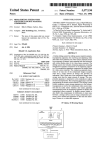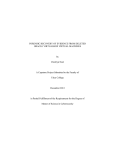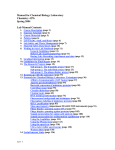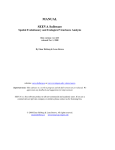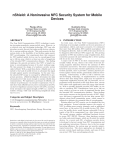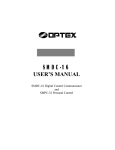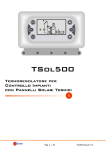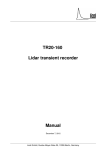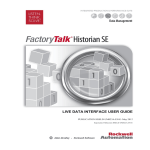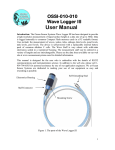Download Risk Assessment of a Power Plant: Evaluating the Security of
Transcript
Lathrop, S.D., Gates, C.L., Massie, D.D. and Hill J.M.D.
Risk Assessment of a Power Plant:
Evaluating the Security of a Supervisory
Control and Data Acquisition (SCADA)
System
ABSTRACT
With the increased potential of a bona fide cyber terrorist attack and the possibility of a future
“war in the wires”, we must continue to sterilize the networks connected to critical infrastructures. This
paper provides a risk assessment of an existing operational computer network used to control a boiler
system generating power and heat for an installation. The methodology used in evaluating the security
of the system is described along with specific recommendations for minimizing the risk associated with
connecting the network to the Internet for the purposes of remote data collection and administration.
Our assessment and proposed recommendations may be applied to any critical infrastructure with a
requirement for remote administration and/or data collection.
INTRODUCTION
As an aftermath of the terrorist events that transpired on September 11th, 2001, the President
of the United States created the Office of Homeland Security to analyze, plan and coordinate the interior
defense of our country. One of the critical components of this new organization was the creation of the
President’s Critical Infrastructure Protection Board (CIPB) tasked “to ensure protection of information
systems for critical infrastructure, including emergency preparedness communications, and the physical
assets that support such systems” ("Executive Order on Critical Infrastructure Protection"). Within a
year, the organization in conjunction with computer security experts from academia, industry, and
government, produced a draft national strategy to secure cyberspace which outlines some of the critical
steps required for the United States to secure its information systems from deliberate cyber attacks.
The key sectors addressed in this document were the critical infrastructures such as banking and
finance, transportation, and electrical power. This document was recently finalized and endorsed by
the President of the United States (Clarke and Schmidt 2003).
The forensics analysis of al Qaeda computers seized from the caves of Afghanistan in the
spring of 2002, suggest an extremely high level of interest from this terrorist group into how to remotely
control, through the Internet, electrical substations, pipelines, dams, and communication grids (Gellman
2002). The devices used to control such systems remotely are called supervisory control and data
acquisition, or SCADA, systems. They use their own application protocol but employ the standard
Transmission Control Protocol/Internet Protocol (TCP/IP) protocol used by computers to communicate
across the Internet and local intranets. The computer devices used to control critical systems and
protocols they use to communicate are often not well understood except for the vendors who develop
them. Because they are not as common as the familiar Internet application protocols they are not
subject to the constant scrutiny of the Information Assurance community. However, the threat against
such systems is real. One utility reported 100,000 scans a month in 2001 (Dagle, Widergren et al.
2002).
The problem with such a situation is that assuming information systems are secured because
the nodes on the network and the protocols used to communicate are obscure, is a fatal mistake.
Obscurity only slows the development of attacks on the system. Given enough time and money to
replicate the devices used in the system, a motivated cyber agent or cyber warrior will develop tools to
attack the system. The proliferation of such tools to the computer underground is then trivial (Welch
2002).
In this paper we describe a risk assessment of a power plant’s information system. The power
plant is real and operational with a network of control devices and computers controlling the plant’s
1
central boilers. The plant is capable of producing over 5MW of electricity as well as central heating.
Ultimately, the goal of the project is to reduce the cost of operating the plant by remotely administering
the system and enabling a software application to dynamically control the mechanical equipment. The
software makes decisions based on several attributes such as electrical and fuel tariffs, ambient air
temperature and the number of personnel on site. The purpose of the assessment is to identify specific
threats and vulnerabilities of the system and then take the necessary steps to minimize the risk
associated with connecting the network to the Internet. In order to fully evaluate the network, we
conducted a penetration test using open source software tools that both cyber attackers (i.e. computer
hackers) and computer security professionals use to evaluate network security. We emphasize open
source tools because these tools are freely available for download on the World Wide Web (WWW) and,
thus, could be obtained by anyone. An organization with more resources could purchase more
advanced tools or modify the open source software tools to fit their needs.
FACILITIES AND MOTIVATION
The central plant was originally built in 1903 as a heating facility. However, upgrades over time
have changed it into a cogeneration facility that is capable of providing up to 5.2 MW of emergency
power. The plant consists of two 1.25 MW steam turbines and one 1.65 MW steam turbine. High
pressure (1.2 MPa) and low pressure (184 kPa) steam lines, acting as the condenser for the plant,
provide heat to buildings. Due to steam pipe losses and process loads, only 40% of the steam
condensate returns to the central plant. Make-up feed water, from a local reservoir, is mixed with the
condensation that returns from the heating load. Once mixed, the water is pumped to any combination
of the three boilers in the system. In 1993, a 1.2 MW diesel generator, intended for peak shaving
(demand reduction), was added to the plant.
The organization purchases grid electrical power under a fixed price of demand [kW] plus
energy charges [kWh], which varies by time of year. Since electricity can usually be purchased for less
cost than producing it on site, local power generation is only economical for peak shaving or when
cogeneration is possible. Since the only condensing capability is from the heating and processing
loads, the steam turbines can only be economically run during winter months. The diesel generator may
be operated at any time of year, however waste heat recovery is not possible with the current
configuration.
The plant had traditionally been controlled by operators who set its operation based upon their
experience. Unfortunately, they often did not operate the plant optimally because they lacked access to
certain information. Such information included site population, hourly weather predictions, and electrical
price signals. In some cases, the plant operators were not trained in all the subtleties of plant operation.
This sub optimal performance can be improved with a clear methodology of how plant equipment
operates and interacts.
An artificial intelligence, agent-based software application is being developed that takes input
from equipment sensors, building thermal loads and electrical profile coupled with rates from a remote
location, and determines the combination of equipment that would afford the least cost option for
providing power and heat. This information is used to produce accurate models, which increase the
ability to operate the plant efficiently. While this information could be collected manually, operator error
would be minimized if the program were fully automated.
The SCADA system uses component off the shelf (COTS) technology. The operating systems
and the applications they run, along with the communication protocols used to exchange information
between devices, are subject to the same sort of attacks that are used everyday on the Internet. The
weakest link, the human element, is subject to attack through social engineering, weak or no
passwords, poor policy, and improper configurations.
The security of the system and assurance of its information is paramount. In order to provide
the functionality desired, the system must be connected to the Internet. To prevent cyber attacks
against the plant requires a risk assessment of the current infrastructure and hardening of the final
implementation.
RELATED WORK
Published work in this area is very sparse. This may be because results of such assessments
are not releasable to the public or, worse, tests such as described in this paper are not being
2
conducted. Government and private agencies are continuing to investigate protection and security of
critical infrastructure. Their recommendations consists of making industry aware of the threat and
potential vulnerabilities associated with their SCADA systems, provide assistance in the form of a
training and penetration tests similar to the one described in this paper, and establish partnerships
between the National laboratories and industry in order to leverage each organization’s expertise.
Similar to this paper, their presentation describes the typical vulnerabilities observed in SCADA systems
(Dagle, Widergren et al. 2002). The difference between this paper and their presentation is that we
present a more thorough risk assessment including results from a vulnerability assessment.
RISK ASSESSMENT
We use the Information Assurance (IA) model (Figure 1) presented by Maconachy as a
framework for assessing an information system. The model describes four dimensions: (1) information
states, (2) information services, (3) information security measures and countermeasures, and (4) time
(Maconachy, Schou et al. 2001).
The power plant uses information that can be in any one of three states at any given point in
time: (1) processing, (2) transmission, or (3) storage. When assessing the security of that information,
one must consider all three states. The types of security services a system can provide include
confidentiality, integrity, availability, authentication, and non-repudiation. We focused our evaluation on
the first three services. When considering where one may accept risk, confidentiality may be the least
important attribute as the power plant still operates even if an outsider is able to view the information.
On the contrary, the integrity of the data is very significant. Any modification of the data may cause
damage or loss. For example, a data packet with incorrect values may be sent to a boiler computer that
in turn directs the combustion subsystem to over compensate the air to fuel ratio. Or, incorrect
information could be feed to the software application, leading to incorrect predictions. In every case
availability is important as the loss of data to the system degrades, or possibly, disables power and heat
generation. Availability and integrity over time is a particularly important factor for control systems as
updates to the controllers happen in real-time. Any disruption to the flow of information can result in the
system becoming desynchronized.
Figure 1: Information Assurance Model
As with any risk assessment process, the ultimate goal is to reduce risk to an acceptable level
without giving up the functionality and performance required by the organization. In the context of the
Information Assurance model, risk is the probability that a particular threat is manifested against a
specific vulnerability in the system that undermines availability, integrity, or confidentiality. One cannot
eliminate risk in the information system without physically disconnecting the computers from the network
3
and burying them in a hole. Obviously such a solution defeats the purpose of deploying and using the
technology in the first place.
The model’s security countermeasures enable one to reduce risk. These countermeasures
include technology; policy, procedures, and practices; and the people within the organization
administrating and using the system. Most people will immediately associate security counter measures
with computer security applications such as firewalls, anti-virus software, and patches. In most cases,
however, the people, policy, and procedures play the most important role in determining the overall
security of an information system. Throughout the remainder of the paper we will use the IA model as a
roadmap for our discussion. First we will look at the threat and potential attacks against the three
security services we studied (confidentiality, integrity, and availability). Then we will look at the
vulnerabilities we found as it relates to each of the information states and provide recommendations in
terms of the security countermeasures.
The Threat
Based on our penetration test and an analysis of the protocols and platforms used in the power plant,
we conclude that there are three major forms of attack against the power plant’s infrastructure, each
with an increasing degree of severity.
Integrity attack on the information. This type of attack involves modifying the information
stored in databases and transmitted across the communication networks. Such an attack’s visible end
state is an unknown decrease in the efficiency of the power plant’s generation of power or heat resulting
in a higher cost to operate the plant. Such a scenario involves an attacker modifying the current cost of
electrical power, number of personnel, ambient air temperature or data returned from the boiler’s
sensors that is either stored in the databases or in transit. Modification to the data causes the software
relying on the information to incorrectly adjust boilers and either over or under produce steam resulting
in an inefficient process, lack of confidence in the design capacity during critical loads, and any
competitive edge that the control software was supposed to provide. This is exactly the opposite result
desired by the designers of the agent-based control software.
Availability attack on power generation. The second attack is an availability attack (also
known as a denial of service attack). The attack causes degradation in the facility’s ability to generate
power. There are two possible ways an attacker could perform a denial of service attack against the
power plant and effectively prevent it from producing power or heat. The first is a very overt, noisy
attack where the attacker sends several thousand packets, or “pings of death” in hacker terminology, to
control computers running on the power plant’s internal network. The victim computer(s) become
overwhelmed with packets and are unable to perform their primary function as they are busy attending
to the large number of incoming packets. Another possibility for such an overt attack is for the attacker
to execute an exploit that effectively shuts down a device on the network responsible for maintaining
network connectivity. A network router is an example of such a device, and an exploit in this context is
a computer program takes advantage of a particular vulnerability in software. Once the router can no
longer perform its connectivity function, communication ceases between computer nodes on the
network and information cannot be transferred to the boilers’ controllers. This action results in
degradation to default operations.
The second and more dangerous method an attacker could use to temporarily disable the
power plant is much more covert and relies on the attacker initially gaining access to computer systems
within the plant’s internal network. Based on our analysis, an attacker could gain access to one or more
computers on the network using operating system based attacks, application-based attacks, or social
engineering. If access is gained using a normal user account, escalation of privileges may be obtained
by attempting “user to administrator” exploits (Skoudis 2002). One would believe that such vulnerable
applications and operating systems are not running on SCADA systems used to control boilers, but our
assessment shows the contrary.
Once access is gained on a computer within a central plant, the intruder can then launch
network-based attacks. Again, the attacker could launch a noisy denial of service attack from within the
internal LAN as they are now within the confines of the local network and outside the reach of external
security. However, if they wish to remain overt, a serious cyber warrior could take advantage of the
weak, unencrypted protocols used in control systems and either create their own packets to
4
communicate to the boiler controllers or modify the integrity of the packets already in transit. By simply
“zeroing” out the data in a controller’s registers, the attacker could effectively shut down the power
generation capability of the plant.
Confidentiality and integrity attack against the boiler controllers. The final and most
devastating attack that a true cyber-terrorist may attempt to exploit would result in physical damage to
the plant, and potentially, loss of human life. It is a combined exploit on the confidentiality and integrity
of the information that controls the boilers resulting in an explosion and possible physical damage.
More research into this final attack is required, but theoretically, it is very possible. We describe it in
order to be complete in our analysis, to highlight our concerns with the unencrypted network protocols
used in SCADA systems, and to show the relatively ease of such an attack.
Before describing the attack, it is important to understand the primary purpose of a boiler control
system. A boiler’s controller maintains steam availability and improves efficiency in an effort to reduce
cost and emissions. One of the key subsystems of a boiler control system is the combustion
subsystem. Its function is to deliver the right mix of air and fuel to the burner at a rate that satisfies the
firing rate demand and at a mixture (air/fuel ratio) that provides safe and efficient combustion.
An explosion might occur if you could cause the controller to over compensate the air to fuel
mixture. Forcing the controller to over compensate is a matter of writing certain data to the appropriate
memory location(s) that triggers such an event. In our analysis, it is not obvious with a terse inspection
of the controller’s documentation which memory location controls the combustion subsystem, but a
diligent cyber warrior backed with state-sponsored or terrorist organizational resource would purchase
the equipment and evaluate its operational functionality. It is then trivial to inject a packet or modify a
packet in transit to enable such a memory write.
Vulnerabilities and Recommendations
In order to evaluate the vulnerability of the power plant’s current information technology
infrastructure and provide sound recommendations, we took the approach from an attacker’s vantage
point and used several active reconnaissance based, port scanning tools that an attacker would use to
determine the network topology, operating systems, and open TCP ports running on each machine. We
also employed several vulnerability scanners that attempt to determine the specific vulnerabilities
associated with the computers and their software. Passive reconnaissance measures were also
employed by searching for publicly available information on the World Wide Web that may be of interest
to an attacker.
We also used specific exploitation tools that an attacker would use to further penetrate the
network once access was gained through the vulnerability. These exploitation tools included network
monitoring tools used to monitor network traffic, password crackers, to determine the strength of
passwords on the system, and various other attack tools designed against specific operating systems
and applications to identify security weaknesses.
Because not all tools provide the same information we employed a breadth of tools in
conducting our analysis. It is also important to note that despite the fact that we were physically on site
for our evaluation, if the current topology was connected directly into a switch or router with access to
the Internet, we would have been able to collect similar information. Access to the physical wires is not
necessary as the Internet supports protocols that allow transmission between two interconnected
devices. We used all open source tools to evaluate the system. These tools are freely available on the
Internet. We hypothesize that a true cyber warrior would develop their own in-house tools and purchase
the systems described in the paper in order to increase their capability and specifically target the critical
infrastructure for which they were attempting to gain access.
Although we did not attempt any social engineering attacks on the personnel running the plant,
it appeared that the plant operators would have been very “helpful” in providing useful information such
as passwords, types of software running on the system, and other useful information over the phone or
even in person if we appeared to be the local “IT” guys. During our visit, when we were connecting our
computers into the plant’s network we were never questioned or asked what we were doing even
though we had no name tags, escorts, etc. There appeared to be only one person in the plant even
familiar with the computer systems and that person did not physically work full-time at the plant’s
location.
5
We now provide our assessment and specific recommendations for the power plant’s
information infrastructure by categorizing them using the IA model’s security countermeasures
(technology, policy, and people) as described by Figure 1. We focus primarily on technology but also
briefly address the issues surrounding policy and people.
1) Technology Recommendations. When speaking of technology, we are including the
hardware, software (both operating system and application), and communication networks. Each
has specific vulnerabilities. The discovered network topology from our reconnaissance is shown in
Figure 2 depicts the computer name, operating systems guessed by the port scanning tools, open
ports discovered, and vulnerabilities found. Note that due to the number of vulnerabilities found, we
are highlighting only the critical weaknesses.
Table 2 depicts the purpose of each open port found. It is important to note that this information
was gathered by our tools and is not a result of physically going to each machine or reprinting an
operation manual.
Figure 2: Power Plant Network Topology
There are eight computers connected to the network, each having a static IP address. Four of
the computers were running a vendor-specific Unix operating system. The other four computers were
running the Windows operating system. Additionally, there are two appliances (a router and a switch)
found on the network. The Windows operating systems are familiar to the common hacker and
numerous exploits are known to exist against such systems. The proprietary controllers, on the other
hand are not common on commercial or government network. The networking protocols identified
running on the network included TCP, UDP, IP, HTTP, MODBUS, TFTP, and the Windows specific
NETBIOS protocols.
Highlighted vulnerabilities from include the router. It is running a web server that is susceptible
to a denial of service attack if the attacker attempts to access a particular script. Such an exploit would
enable the attacker to carryout an availability attack on power generation as described previously. The
computers running Windows operating system are extremely vulnerable to numerous attacks. In
particular, the use of the Network Basic Input/Output System (NETBIOS) has several vulnerabilities.
NETBIOS provides the ability to share files or folders across a network through Windows network
shares. Although extremely useful, improper configuration of network shares may expose critical
system files, or may provide a mechanism for a nefarious user or program to take full control of the
computer.
6
Table 1: Discovered Computer Nodes with Vulnerabilities
COMPUTER
NAME
Router
OS
PURPOSE
Proprietary
Enables routing
of network traffic
Boiler1 – Boiler3
Windows
Displays boiler
information and
provides an
interface for
controlling boiler
settings.
Boiler Data
Aquis
Windows
Proprietary
controllers
Unix
Database
collecting boiler
sensor
information
Collects and
stores boiler
sensor
information and
controls boilers.
TCP/
UDP PORTS
TCP-80, 520
UDP–53,67,
69,520
TCP-135,139
UDP-135,137,
139
TCP-135,139
UDP-135,137,
139
TCP-80, 502
VULNERABILITIES
IDENTIFIED
Crashes if a remote attacker
accesses a script on it
It was possible to log into the
remote host using a NULL
session.
Several local accounts have
never changed their password
and have passwords that never
expire; Most accounts are
unused. One account had no
password.
Same as Boiler1- Boiler3
Web server is vulnerable to a
cross site scripting attack.
ModBus protocol subject to
session hijacking, man-in-themiddle attacks, and replay
attacks
Table 2: Discovered Open Ports
PORTS
80
135,
137, 139
502
53
67
69
520
TRANSMISSION
PROTOCOL
TCP
TCP/UDP
TCP
UDP
UDP
UDP
UDP
PURPOSE
Web Traffic
NETBIOS (Network Basic
Input/Output) protocol.
ModBus
Domain Name Server
Bootstrap Protocol
Trivial File Transfer Protocol
Router
For example, a specific vulnerability associated with NETBIOS is the “Null session connection”.
It is a mechanism that allows an anonymous user to retrieve information (such as user
names/passwords and file shares) over the network, or to connect without authentication. It is used
primarily by Windows to account for various critical system operations. When one computer needs to
retrieve system data from another, the account opens a null session to the other computer to perform
the desired tasks. Unfortunately, attackers can also log in as the Null Session. Therefore, if working in
a Windows domain environment, you can minimize the information that attackers obtain, but you cannot
stop all leakage.
Other significant problems found with the computers running Windows primarily revolved
around user accounts. One account had no password making it trivial for an attacker to gain access to
this machine as that user. Once an attacker has access as the user they can masquerade as that user
anywhere on the network where that user has permissions. Worse, an attacker can attempt a “user to
administrator” exploit on the system in order to gain Administrator access. Other accounts had
passwords that had never been changed and were breakable. Finally, there were a few unused
accounts on the system. These accounts should, at a minimum, be disabled or deleted if possible.
7
Leaving unused accounts on the system leaves another avenue of approach open for the attacker to
gain access.
Finally, the computers running Windows stored passwords in both the legacy LAN Manager
(LM) format and the newer, more secure NTLM scheme. In order to support backwards compatibility
with older Windows systems, the LM format is the default method of storing passwords. However, it has
been shown that password cracking programs can easily break the encryption of passwords stored
using the LM format because of the poor implementation of the encryption algorithm.
All of the vulnerabilities found on the computers running the Windows operating system would
subject the power plant’s information system to the first two attacks described previously. A malicious
attacker could either cause plant inefficiencies or temporarily disable power generation by gaining
access to either the computer running the database or the computers used for displaying information
(i.e. Boiler1-Boiler3) and modify the data so that either the operators take imprudent actions or by
sending incorrect data to the controllers.
The proprietary plant control system is a set of control system computers for the plant and
combines the functionality of a loop controller, a process logic controller (PLC), and a distributed control
system (DCS). The system serves as the storage location for the boilers’ sensors and control
information. The system has an auto-configured human-machine interface (HMI) and monitoring
software located on the Boiler1- Boiler3 computers. The power plant’s data acquisition computer uses a
software package that contains a database with the current configuration of the boilers. The controllers
can be configured remotely from this computer using software. Configurations and control information
are transferred over the network from the database to the monitoring software using the ModBus
protocol. Finally, the proprietary controllers run a web server to send graphical control measures to web
browsers on the workstations.
The proprietary controller user’s manual describes the methodology for connecting the system
to an Ethernet network and also states that “security is of paramount importance” but does not give any
specifics besides mentioning that a firewall should be employed to protect the internal network from the
Internet. It does not contain configuration options or details such as firewall recommendation,
configuration considerations, and other security precautions that would minimize risk. We could find no
mention of a risk analysis in any of the documentation.
We found serious vulnerabilities associated with the proprietary control system and the ModBus
protocol it uses to transfer data across the communication network. Each controller has a web server
running on it that allows the plant operator to log into it and adjust settings via a standard web browser.
These web servers are susceptible to a specific attack (cross site scripting). A cross-site scripting
attack is possible when a web server (in this case one of the proprietary controllers) returns content that
includes un-sanitized user-provided data (such as username and password). An attacker could create a
request to the web server (in the form of a standard URL) with malicious data embedded (such as with
JavaScript or VBScript) that redirects certain information (i.e. username and password, session state,
etc) to the attacker’s computer. The URL is then presented to the user (in our case a plant operator) in
the form of a hyperlink. The attacker entices the user with the hyperlink via an email message, an
instant message, or a web message board posting (i.e. “I need you to check on the controller’s status”
“Click here”). If the plant operator follows the link it directs them to the controller’s login page. When
the plant operator attempts to login the credentials are sent back to the attacker. The plant operator
never notices the event, sees only the standard web page after normally logging in, and continues
business as usual. The attacker meanwhile has the plant operator’s credentials and can log into the
boiler controller as if they were the plant operator. This attack may intercept user input, read data from
the controller and send it back to the attacker’s computer, or, allow code to be run on the target system
possibly giving the attacker root or administrator access (Howard and LeBlanc 2002). Once an
individual gains this level of access on a platform they can perform any operation that would be possible
by an administrator of that machine. Such operations include reading or writing data to the controller’s
memory. This vulnerability would allow the attacker to execute any of the three attacks previously
described.
The proprietary controllers use a messaging protocol called ModBus to exchange information.
ModBus is an application protocol that was initially designed as serial line, master/slave architecture
between control devices. It has recently evolved to use a modern Ethernet-based network using the
TCP/IP protocol as the underlying transport/network protocols (Figure 3). The ModBus application
server listens by default on port 502. (Dube and Camerini 2002; "MODBUS.ORG Home Page" 2003)
8
Figure 3: MODBUS Architecture
The ModBus protocol provides communication between computers using function codes that
provide both read and write services. A client device (either a workstation or another device) requests a
read or write from/to a specific memory location on a controller, and the service replies with either the
specific data requested and/or writes the data to its specified memory location which ultimately controls
the air/fuel mixture and boiler sensors. Encryption is not used so all transactions are transmitted in the
clear and can easily be captured and modified with network monitoring tools. An example packet was
sent from a controller to the data acquisition computer. All reads and writes to registers on the controller
could be observed, and if we had desired, the data could have been modified. The request for
comments (RFC) describing the MODBUS protocol specifically states that it “does not discuss security
issues and is not believed to raise any security issues not already endemic to MODBUS
communications. Since MODBUS/TCP is based on TCP/IP, it is not inherently secure.” The
vulnerabilities described that are associated with the proprietary controllers and the ModBus protocol
would allow a cyber warrior to execute any of the three attacks described previously.
There are several technological solutions that one could employ to reduce risk in the system
and significantly increase the probability of detecting attacks and being able to respond appropriately.
This technology includes such tools as intrusion, detection systems, firewalls, honeynets, integrity
maintenance systems, etc. However, overwhelming the people who maintain these systems with new
technology are not always the correct answer especially when their ultimate responsibility is to operate a
plant. Because of this thought process and our assumption that the power plant’s network is part of a
much larger network that provides a defense in depth and whose security is constantly monitored by
computer security specialists, our recommendations merely provide what we believe to be the minimum
technical solutions required to reduce the risk of an attack to an acceptable level.
First, a firewall that segments the internal network from the agent-based system and the
external network must be installed and configured. It should be configured to block all traffic except for
the port required by the agent-based software to perform its analysis. No traffic originating from outside
of the network should be allowed into the internal network. This “deny all” policy will prevent attacks
against the NETBIOS, http, and MODBUS protocols from a remote attack assuming that the protocol
used by the agent-based protocol is secure and the firewall is configured correctly.
9
All services/ports that are not required must be closed. This prevents all exploits against those
services. A good example of this is the NETBIOS service. Since there is no requirement to run
Windows “domains” or to allow file shares in this architecture, disabling NETBIOS will preclude the
exploits against this protocol. The router’s port 80 (web) can be disabled and configured from a
HyperTerminal setup instead to preclude a denial of service attack.
There are a few security countermeasures that the designers of the agent-based system will
want to include in their final implementation. Integrity maintenance software should be installed on all
systems in order to detect any attempts to modify files. In order to secure the transmissions between
the agent-based system and the database, a protocol such as secure sockets layer (SSL) or IPSEC
should be used with the data that is stored in the database encrypted using a strong encryption
algorithm.
The final two recommendations are strongly tied into the policy and training of the people who
use the system. The first recommendation is that software patches to operating systems and
applications must remain current. Software patching will preclude known vulnerabilities although it is
ineffective against unpublished vulnerabilities. Furthermore, system administrators must properly
configure the operating and application systems and insure that the policies are set for the best security
posture. For example, disabling the Windows LANMANAGER authentication mechanism will insure that
only the more secure and stronger encryption implementation found in NTLM is used. Several security
checklists exist for system administrators to insure their systems are locked down as much as possible.
Users of the systems must have strong passwords and these passwords must be checked with
password cracking software. Most forms of authentication, as well as file and data protection, rely on
user-supplied passwords. Every account that is required must have strong passwords and
administrator accounts should be especially protected. Any application that is installed for the first time
must have the password immediately changed as the hacker ungrounded has a database of default
passwords for a myriad of applications.
Finally, as is often quoted in some sports, the best defense is a good offense. Vulnerability
assessments from an external source should be performed on a regular basis in order to insure
maintenance of the system is taking place and that patches to thwart new vulnerabilities found are
current.
Policy Recommendations. Again referring to Figure 1, we see policy and people identified as
security countermeasures. In general, policy must be established and enforced in order to minimize the
risk of connecting the power plant’s internal network to the Internet. Clearly defined roles and
responsibilities to defend cyberspace are important for managers, system administrators and users.
The network architecture must be documented and critical systems such as proprietary controllers and
databases must be identified and the additional security measures to protect these systems should be
documented. A rigorous, ongoing risk management process must be established and enforced.
Policy should include procedures for both users and administrators. Some examples include
how often passwords are changed, where log files are stored (on the host machine or off-site), how
often logs are reviewed, when systems are backed up, and procedures for recovery. Passwords should
be changed periodically (i.e. every 3-6 months) in order to prevent an attacker who has acquired the
password accounts through other attacks, time to crack those passwords. Given enough time a majority
of passwords can be cracked unless they are very strong. Forcing users to change passwords
frequently results in bad passwords or re-used passwords. Administrators should have an alternate
account for normal logging into the systems, and should use their administrator’s account judiciously. A
formal procedure should be in place for conducting a vulnerability assessment similar to the one
outlined in this paper. Additionally, the policy should address how often training should occur for both
users and administrators.
People Recommendations. Looking closely at security measures and counter measures, it is
apparent that policy, technology, and people together have a synergistic effect on the security of an
information system. Of these three elements, people are the most important. We believe that one of
the main problems in the security of a SCADA network is that the people running the system, although
well versed in the mechanical and electrical components of the system, often have little or no
knowledge in how to secure the information technology. Most of the recommendations involve keeping
up with the latest software patches. This involves training the system administrators to remain current
10
with the latest vulnerabilities, running their own vulnerability assessment tools, and applying the latest
patches. Note that such a methodology will not stop unknown attacks that a full-fledged cyber-warrior
may launch, but these measures will preclude easy attacks.
More education and training is required. People must build, install, configure, and maintain the
technical aspects of information systems. If technology is implemented improperly or is used without
the correct policies and procedures to support it, these technologies can actually reduce the overall
security of an information system. Finally, it is people who must hire, retain, and sometimes fire other
people who use and maintain these information systems. Without education and training in such
matters information security measures are nearly worthless.
FUTURE WORK
Based on our findings a more in depth security of the MODBUS protocol and the proprietary
system are required. Clearly, the MODBUS protocol is vulnerable to attack and anyone could easily
inject or modify data. The application should be encrypted using a strong encryption algorithm and a
mutual authentication scheme should be put in place. In order to clearly identify the capabilities of the
proprietary control system and what aspects of the boiler system it can control, more analysis is
required. The purpose of each memory location requires investigation in order to determine what
physical aspect of the boiler control system can be influenced. It is clear to us that by modifying or
injecting packets destined for a controller can temporarily disable a system. What is not clear is the
physical damage that may be caused with such an attack. From a vendor’s standpoint, more work is
required to determine what steps an administrator of a proprietary system should take in order to
properly secure their system. The manual should include these steps. After the implementation of the
agent-based system and our recommendations, a re-evaluation of security should take place.
CONCLUSION
In this study we conducted a risk assessment of a real power plant’s supervisory control and
data acquisition systems (SCADA). The methodology described and proposed recommendations may
be applied to any critical infrastructure with a requirement for remote administration and/or data
collection. There are several vulnerabilities associated with the current network that a motivated cyber
attacker could, at a minimum cause inefficiencies in the system or disable it, and in the worse case,
cause physical damage. Our recommendations include technical, policy, and training
recommendations. Additionally, we conducted a cursory examination of the MODBUS protocol and
determined that, because data transmission is unencrypted, it is vulnerable to passive and active
eavesdropping, session hijacking, man in the middle, and replay attacks. Work needs to continue on
improving the security of this protocol.
Assuring information is not an all or nothing endeavor. One must balance the desired
functionality and performance required in an information system along with security. There is no
“secure” or “non-secure” technical solution. Security includes the entire environment to include
technology, the policies, and the people—and it is not free. One must determine what level of risk is
acceptable and then make every effort to minimize that risk with appropriate security solutions. We
would argue that in a critical infrastructure, such as a power plant, where the cost of physical damage is
immeasurable monetarily, one must make every effort to secure their information system from a cyber
attack.
Acknowledgement
The primary author would like to acknowledge COL (Dr.) Daniel Ragsdale for sparking his interest in
information assurance and critical infrastructure protection.
11
REFERENCES
Clarke, R. A. and H. A. Schmidt (2003). The National Strategy To Secure CyberSpace. Washington
D.C., The President's Critical Infrastructure Protection Board: 65.
Dagle, J., S. Widergren, et al. (2002). Enhancing the Security of Supervisory Control and Data
Acquisition (SCADA) Systems: The Lifeblood of Modern Energy Infrastructures. IEEE Power
Engineering Society Winter Meeting, New York City, NY, IEEE.
Dube, D. and J. Camerini. (2002). "MODBUS Application Protocol: Internet Draft." Retrieved February
7, 2003, from http://www.ietf.org/internet-drafts/draft-dube-modbus-applproto-00.txt.
"Executive Order on Critical Infrastructure Protection." Retrieved January 29, 2003, from
http://www.whitehouse.gov/news/releases/2001/10/20011016-12.html.
Gellman, B. (2002). Cyber-Attacks by Al Qaeda Feared. Washington Post. Washington D.C.: 4.
Howard, M. and D. LeBlanc (2002). Writing Secure Code. Redmond, WA, Microsoft Press.
Maconachy, W. V., C. D. Schou, et al. (2001). A Model for Information Assurance: An Integrated
Approach. 2001 IEEE Information Assurance Workshop, West Point, NY.
"MODBUS.ORG Home Page."(2003). Retrieved February 15, 2003, from
http://www.modbus.org/default.htm.
Skoudis, E. (2002). Counter Hack. Upper Saddle River, NJ, Prentice Hall PTR.
Welch, D. (2002). Adversary Threat Taxonomy. IEEE Information Assurance Workshop, West Point,
NY, IEEE.
12












